Popular technologies Node.js and Java streamline software development. Node.js is a practical runtime environment for both frontend and backend development, while Java is a programming language compatible with any device or operating system. Let us evaluate which technology will be the most effective for you.
What Is Node.js?

‘Node.js extends the creative potential of people with web development experience, enabling a new generation of developers to create servers, command-line tools, desktop apps, and even robots.’
Github.com
Node.js enables backend development across multiple platforms with its open-source JavaScript runtime environment.
Node.js primarily allows JavaScript code execution outside of web browsers. It also facilitates efficient input/output device interactions through APIs and the ability to connect with third-party libraries that use other programming languages.
Node.js empowers developers to build real-time applications, chat apps, scalable mobile apps, and perform embedded programming. It achieves exceptional runtime performance thanks to engines like V8 that compile JavaScript into native machine code before execution, rather than interpreting it line-by-line.
The power of Node.js lies in its capability of processing multiple concurrent requests to and from the web server (I/O). It accomplishes this through executing all requests on a singular thread, thereby facilitating thousands of simultaneous connections. This feature enables Node.js to offer incredibly swift and efficient performance, making it ideal for backend development.
Node.js has become a popular choice for building large media services due to its simplicity, fast speed, cost-efficiency, and JavaScript-based nature.
However, Node.js is not only applicable to these scenarios. Developers employ its versatile JavaScript-based technology in various fields, such as embedded systems, eCommerce, and the Internet of Things (IoT).
Frameworks: Express.js, Sails.js, and Partial.js, etc.
What Is Java?

‘Today, Java not only permeates the Internet but also is the invisible force behind many of the applications and devices that power our day-to-day lives.’
http://www.oracle.com
Dedicated Java developers have used this platform-independent software programming language for over 27 years and it remains a prominent language in the industry. Java has gone through tremendous transformation and currently holds a vast part of the modern IT world owing to its dependability, protection, and steadiness.
It is remarkably versatile and convenient, with the capacity to function on many operating systems and devices. Initially designed to enhance TV interactivity, Java support for concurrent computing, networks, and GUIs has garnered a large developer community.
A great variety of industries use Java programming, including Fintech, eCommerce, industrial automation, and big data solutions. Java applies in different areas, including science, banking, online marketing, social media, and data analytics.
Java has a plethora of libraries and frameworks that help developers in their work. The technology is continually growing with the support of an active developer community, incorporating new features that expand its potential and make it even more robust in newer versions.
Frameworks: Spring, Struts, JSF, Tapestry etc.
Pros and Cons of Node.js
✅ Scalability. One of Node.js's prime benefits is scalability. Its asynchronous nature makes it ideal for building interactive, real-time apps, and it can readily scale with expanding business needs. Implementing microservices and leveraging clustering capabilities further boosts scalability.
✅ Cost-efficiency due to full-stack development. Node.js is praised for its cost-effectiveness as it uses JavaScript for both server-side and client-side, reducing the need for additional programmers and expenses. This facilitates effective collaboration among developers and mitigates misunderstandings in Node.js projects.
✅ Quicker time to market. Leveraging full-stack development allows companies to reduce time-to-market, leading to faster availability of their products and services, thus enhancing customer satisfaction.
✅ Multi-platform development support. Node.js is a versatile tool that enables efficient application development across various operating systems and devices, making it an excellent choice for multi-platform development.
✅ Efficiency and lightweight. Being an event-driven environment, Node.js is lightweight and powerful, ideal for data-intensive real-time applications.
✅ Caching possibility. Node.js allows developers to utilize caching, storing frequently accessed data locally for quick retrieval. This feature boosts performance and reduces server load, especially beneficial for high-traffic websites.
✅ High speed of adoption. Developers favor Node.js due to its foundational use of JavaScript, a familiar programming language that's easy to use. Known for its outstanding performance and rapid speed, Node.js is a preferred technology among many developers.
✅ Large and active community. Node.js has a thriving community, where members actively support each other, share ideas, knowledge, and inspiration.
❌ Security issues. Due to the lack of robust native libraries, Node.js developers must depend on third-party tools, which could compromise security.
❌ Inadequate documentation for beginners. Novice developers might find the Node.js documentation lacking, desiring more detailed instructions to meet their needs.
Pros and Cons of Java
✅ Great IDEs. Java tools offer more advanced capabilities for editing and operating on running source code. Java developers have access to powerful integrated development environments (IDEs) such as Eclipse, NetBeans, and IntelliJ with a wide range of debugging and server tools.
✅ Easy to adapt. Java is known for its ease of use and simplicity, making it accessible to developers of all skill levels.
✅ Simple syntax. Developers find it easy to read and understand Java's syntax because they often describe it as being very similar to human language.
✅ Bottom-up security. Built-in language security features enforced by the Java compiler and virtual machine make Java one of the most trustworthy languages for enterprise, financial, scientific and web development.
✅ Platform-agnostic nature. Its platform-agnosticism makes Java a crucial feature, offering developers the flexibility to use the same code on different platforms. Java's Virtual Machine can load, verify, and execute Java code, to ensure its accuracy and security in multiple operating systems.
✅ Robustness. ‘Robust code’ means that your program considers the code handles all the possibilities of an error. Java has a strong memory allocation and an automatic garbage collection mechanism. It provides a powerful exception-handling and type-checking structure as compared to other programming languages (e.g. JavaScript and Python).
✅ Integrations. Java is great at integration - there are specifications and implementations for incorporating many kinds of systems that you're likely to run into in an "enterprise" environment.
✅ Cost-efficiency. Developing Java applications requires minimal financial investments.
✅ Portability. The versatility of Java is an asset, as it offers high compatibility across various devices and platforms.
✅ Remote debugging support. Java offers a notable benefit of remote app fixing. Utilizing the Java enterprise stack, developers can leverage advanced servers, leading to improved telemetric activities.
✅ Active and large community. Developers can rely on the Java user community for help.
✅ Stability. Java has a significant advantage in terms of its high steadiness, which is maintained by frequent updates and improvements that work to eliminate any errors present in the language.
❌ Need for large memory space. Java experts have developed advanced libraries for converting data into Java objects, which can be a complex and resource-intensive process. However, Java requires a substantial amount of memory, and its use may negatively affect performance.
❌ Periods of low performance. A common concern among developers is the performance of Java, as it can consume a significant amount of memory. If proper backup facilities are not in place, data storage can become an issue. Complex concurrency can lead to abstractions instead of threads, complicating development.
❌ Poor GUI builder. Some developers suggest that other languages, such as Python, may offer better options for GUI builder. Complexity and verbosity are common criticisms of Java coding.
Key Differences: Node.js vs. Java
Performance
Node.js
Node.js's no-buffering feature outputs data in chunks, resulting in faster runtime.
Java
Java is a high-performance language, but it might be slower due to its use of compilers. We can see Java's ability to collect garbage as both a benefit and a disadvantage.
We’ll observe Node.js and Java efficiency through this benchmark:
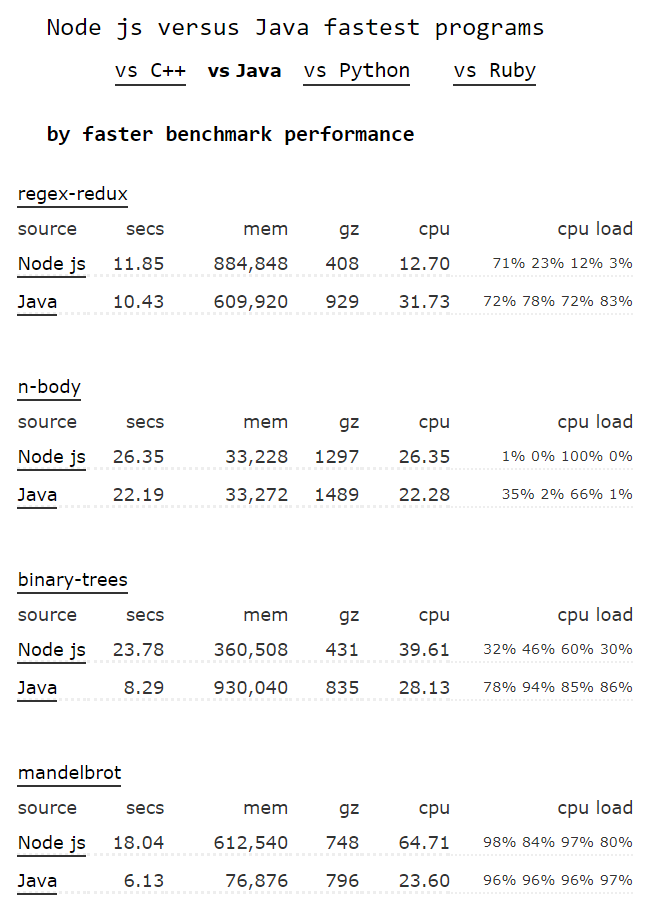
Java shows itself well: it spends rather less time on handling requests than Node.js.
Verdict: Both
Scalability
Node.js
Node.js is a robust platform for building scalable applications that can handle high traffic. The non-blocking input and output system and an event-driven architecture enable it to manage multiple requests simultaneously.
Furthermore, Node.js incorporates an event-loop system which permits the server to process a considerable number of requests productively, resulting in increased scalability and efficiency.
Node.js takes advantage of a distributed system for greater scalability and efficiency.
Java
Java is a widely used language for developing enterprise applications, renowned for its superior performance and scalability. To get the best results, developers must use the proper techniques when adding computing resources like RAM and CPUs.
Java offers several scaling options, including vertical and horizontal scaling, as well as solutions for the single point of failure issue. Moreover, Java's architecture is highly adaptable, capable of meeting a wide range of application requirements. Through the utilization of external applications, Java may increase its scalability, which it may lack natively.
Verdict: Node.js
Security
Node.js
Node.js is vulnerable to security risks, such as the absence of default error handling, which can be a significant safety issue. Moreover, the JavaScript environment used in Node.js is susceptible to attacks like npm phishing and denial-of-service attacks on servers. The JavaScript environment, including Node.js, is prone to Denial of Service (DoS) cyberattacks as a result of protection flaws in third-party npm packages.
Java
Java is famous for its robust security features, and most of its weak points originate from integration issues rather than inherent flaws in the language design. To further improve safety, developers can use TypeScript, a popular statically typed implementation for languages like Java. This helps prevent type-related errors, while bytecode verification in Java checks all code before running, ensuring an additional layer of protection.
Verdict: Java
I/O Communication Model
IO is decrypted as an Input/Output communication model. Basically, it describes entering or displaying the data and refers to the data itself entered or shown by the computer.
There are two types of I/O calls: blocking and non-blocking. Blocking IO means that a thread cannot do anything more until the IO is fully received. While a thread assists an IO request, the non-blocking IO allows it to handle the others, with no waiting for implementation of each (if needed, the request is queued straight away and processed later).
Basically, it looks like that:

In synchronous I/O, a thread assists a request and enters a wait state until it completes this request. A synchronous type allows a thread to continue processing another request until the operation is complete and decreases the time of implementation.
Node.js
Node apps are asynchronous and non-blocking. Making synchronous and blocked frameworks, such as ASP.NET and Django asynchronous, will take extra energy. Compared to the others, no additional action needs to be taken with Node.js.
Java
Java communication is of a blocking nature. The developer here will expect every IO request or start a thread per request. While non-blocking he can send off multiple requests. In current Java versions, both synchronous and asynchronous processes are available (depending on the method, class, and object being called).
Verdict: Node.js
Single vs Multi-threaded
Node.js
Node.js is single-threaded, which means that we have one thread to deal with all requests. Once a request arrives, that thread is used to handle it. No need to wait on a database query to return the data. While a database is executing our query, that single thread will serve another request.
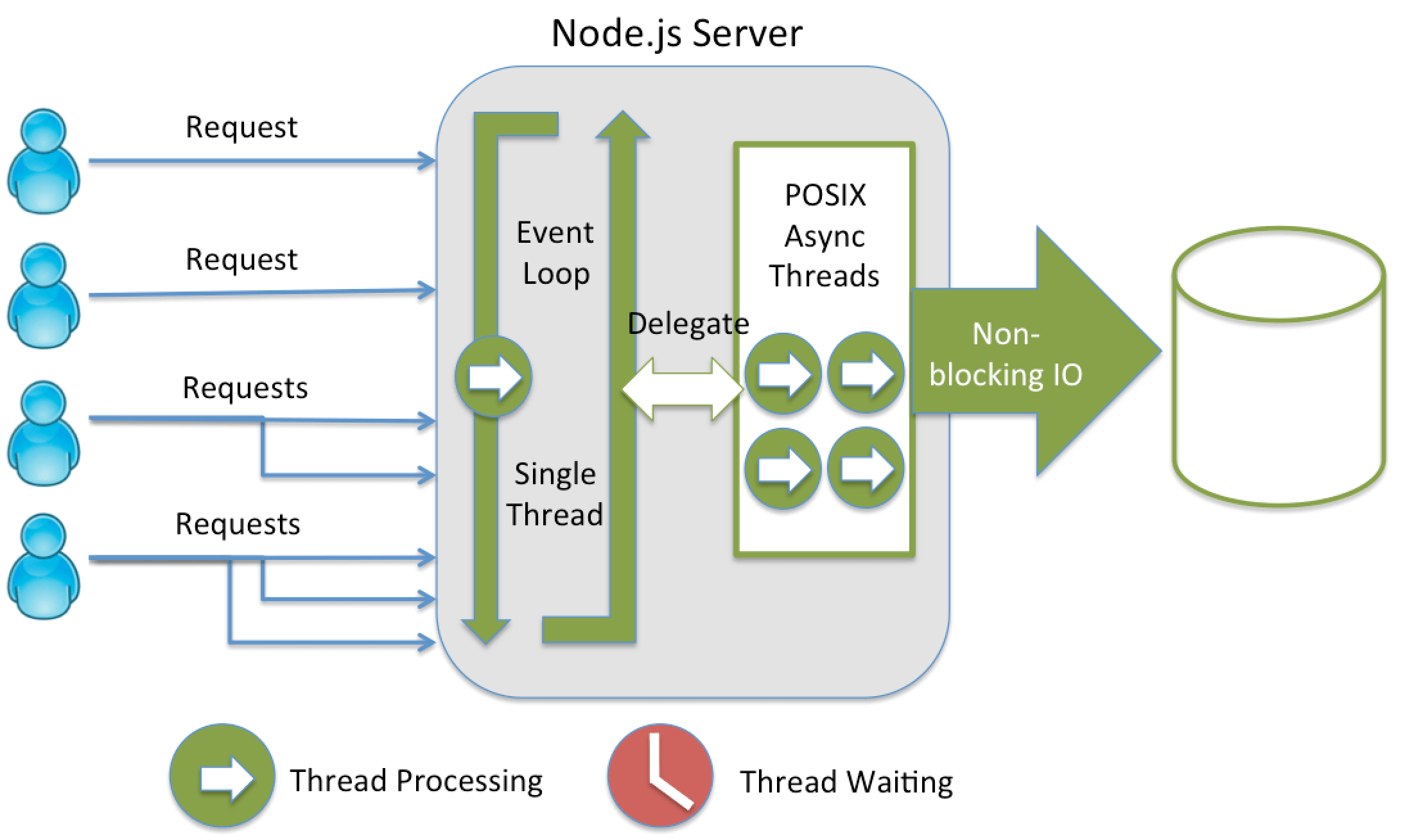
When the database finishes its job, it puts a message in the Event Queue. Node is continuously monitoring this queue, and after it finds the event, just takes it out and processes it. This kind of architecture makes Node ideal for I/O-intensive apps that include a lot of disk or network access, therefore we can serve more clients, without the need of throwing more hardware. And that is why Node applications are highly scalable.
However, a downside to this is that while one client is being serviced, the others have to wait. For that reason, Node shouldn’t be used for CPU-intensive applications (video encoding, image manipulation service etc.).
Java
On the other hand, Java is multithreaded , which means that they may perform simultaneously several tasks within a program.
Whereas other languages require operating system-particular procedures in order to enable multithreading, Java has made multithreaded programming integration smooth.
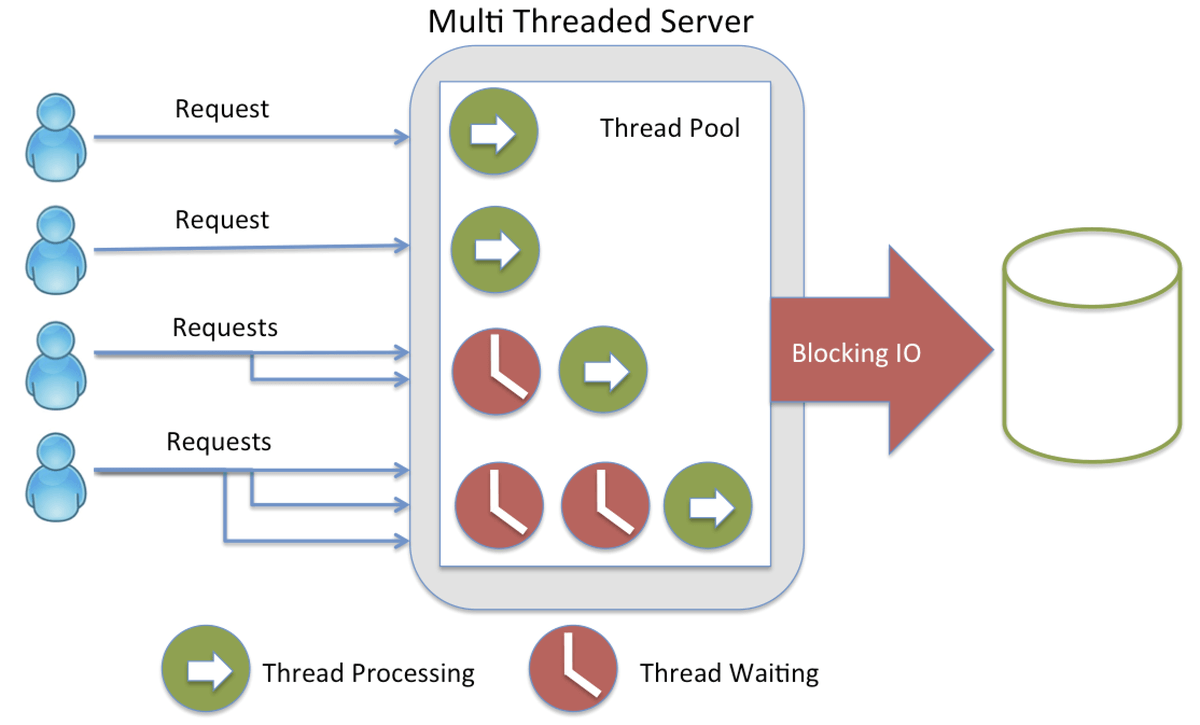
Basically, multithreading helps applications to perform better. So, for large-scale projects that involve concurrency, Java is highly recommended whereas Node.js does not handle the thread and Java does. This is the weakest point of the JS environment.
Verdict: Java
Speed of coding
Node.js
A widespread opinion is that Node.js coding is more swift than Java. Note that project type and team size can affect coding speed.
Java
It often considers the Java programming language requiring more time to write code compared to other languages. However, the actual duration may vary based on various factors, such as the complexity of the project and the number of Java developers involved.
Verdict: Node.js
Cost of development
Factors such as complexity, management, and drawbacks can complicate cost estimation. Getting multiple quotes from various businesses is beneficial to an in-depth perspective of the likely cost. This approach can help ensure that all costs are accounted for, enabling you to make informed decisions about your project budget.
Node.js
The typical annual salary for a Node.js developer in the United States is over $120k.
Java
The average annual pay for Java developers in the USA has exceeded $117k.
Verdict: Varies
Database support
Node.js
Node.js works well with different databases, including NoSQL and relational databases. This makes it a great fit for NoSQL databases, as it supports storage of data in JSON objects, which complements Node.js' JavaScript-based backends. Node.js also has a dedicated library for object data modeling with MongoDB, which enhances code readability and flexibility, leading to improved developer productivity.
Java
Popular databases used with Java include MySQL, SQLite, and PostgreSQL.
For simpler projects, Java has built-in databases that developers and programmers can use. Additionally, JDBC-enabled databases can address the challenges of relational databases.
Verdict: Both
Community
Node.js
Node.js and Java have large and active communities of developers. As Node.js is a more recent technology, its user base is comparatively smaller.
Node.js

The ability for Node to increase the range of JavaScript and development became clear and led to a rise in popularity.
According to StackOverflow, the global usage of this environment breaks the records:
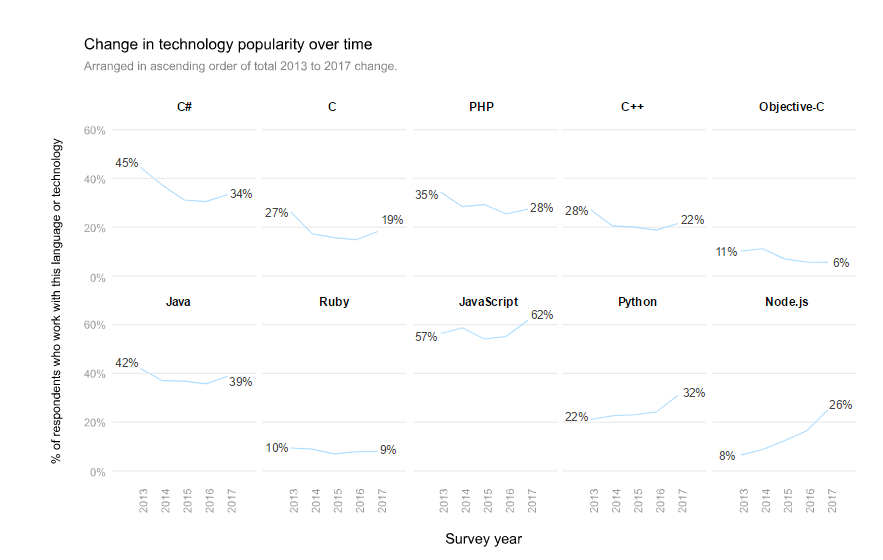
The rate ascended from 8% to 26% in four years, and is still going up.
The number of countries that accept programming as a key factor for advancement is still on the rise. And the USA, are currently one of the most progressive “employers” in the world:
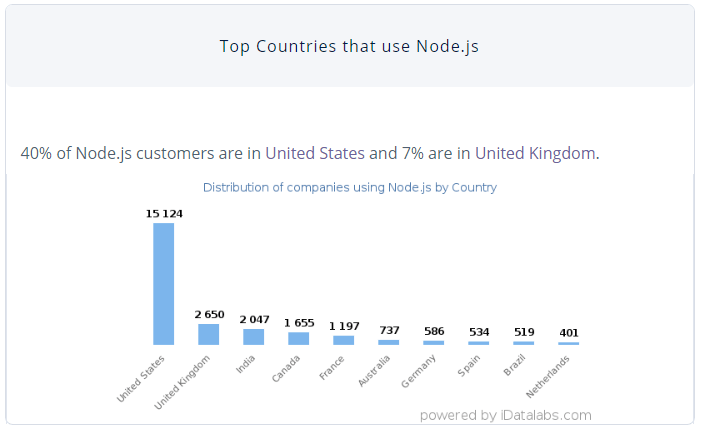
Companies that use Node.js, by the revenue:

Node.js only started reaping the benefits of the overall excitement. And there’s a reason: JavaScript became more versatile, Node itself is rather simple in use, novice-friendly and has an extensive “support” for developers (libraries, community etc.).
Java
Java has been around longer than Node.js, and as a result, it has a larger community of developers.
Java has been here over 20 years and is still in demand:

Programming may be compared to what is happening in the fashion industry: certain languages may decline in popularity, while others have experienced a surge. People want their new tools to be more simple and omnipresent. And that is the answer why so many people got hooked on Java in the late 90s.
The narrative has not changed a great deal; Java is still a language that can be employed on various platforms and for diverse ends. See what countries Java has successfully inhabited:

Even-so, the market is ever-evolving. Such giants as C and C++ are not utilized the way they used to be 20 years back. The stability, security, and reliability of Java is why modern IT companies give it a thumbs up. The following TIOBE index graph displayed the total attitude:

Verdict: Both
Microservices compatibility
Node.js
The Node.js platform has strong compatibility with code and service modules.
Java
Java frameworks, such as Spring Boot and Annotation Syntax, offer exceptional compatibility, making it well-suited for the microservice architecture.
Verdict: Both
Documentation
Node.js
The Node.js documentation page provides a comprehensive guide to the language, including detailed API reference documentation, information on ES6 features, and helpful guides to assist developers in using Node.js effectively.
Java
Java's documentation is a comprehensive and invaluable asset for developers regardless of their experience. This language is abundant in information, from commonplace to more specialized features. This gives developers a thorough comprehension of the language and its potential.
Verdict: Both
Easiness to learn
Node.js
Its syntax and JavaScript interpretation make Node.js easier to learn, especially for those familiar with JavaScript. It provides a better coding experience and simplified coding syntax, making it an appealing choice for constructing efficient and scalable applications.
Java
Compared to Node.js, Java has a more complex ecosystem and can require more time and effort to learn. Despite the difficulty in learning Java, it is achievable with commitment and effort. Even with its complex nature, Java remains a popular and powerful language for developing a wide range of applications.
Verdict: Node.js
Deciding on Node.js or Java
When to use Node.js
Node extricated JavaScript from web browsers and revealed itself as a flexible tool that is highly esteemed by the prominent companies listed above.
Node.js provides developers with the opportunity to take advantage of JavaScript for both their frontend and backend development. Maximize the benefits of JavaScript for development:
- Fast and scalable server-side apps
- Small-size projects
- Real-time applications
- Programming tools (npm, bower, jspm, etc)
- Desktop applications
- Android apps
- E-commerce
- Online marketplaces
- Big data projects (Crawlers, parsers, and data collection)
- Message servers and event broadcasting (Chats, Games, Interactive)
- Streaming
When to use Java
‘When web companies grow up, they turn into Java shops.’
Java is usually more practical for backend development because of its restricted frontend capabilities frequently requiring extra frameworks to create contemporary interfaces. Java has a broad application in tech, government, finance, healthcare, insurance, education, manufacturing, defense etc. 90% of Fortune 500 companies use Java for their backend architecture. Yet, because of its speed and scalability, many startups facing rapid growth use Java to power their tools as well. According to iDataLabs, companies that use Java are: 70% small (<$50M in revenue), 13% medium-sized ($50M - $1000M), and 7% large (>$1000M).
Java is well-suited for:
- Complex web applications
- Enterprise software
- Highly concurrent applications
- Android apps
- E-commerce
- Financial apps with high-level security features
- Big data projects
- Social media
- Messaging
- The Internet of Things (IoT)
- APIs
- Scientific applications
Node.js vs Java: What They Have in Common

- Popularity. Java and Node.js both have thriving developer communities that are constantly creating libraries and specialized content. The Java community is more established and versatile, with both beginners and professionals benefiting from a quick resolution of community issues.
- Easy testing. Java and Node.js are both capable of performing well in testing. However, Java follows a more standardized approach, while Node.js is known for its flexibility and adaptability.
- High developers’ salaries. According to Glassdoor, the average salary for both Java and Node.js programmers in the US is more than $100k. Despite the challenge of accurately evaluating the cost because of the various factors that influence the estimations, such as project complexity, management, and limitations, these experts are highly sought after and generously compensated.
What Top Companies Choose: Node.js vs Java
Node.js

- Netflix leverages Node.js to provide a fast, scalable, and modular application, resulting in a 70% decrease in application load times.
- LinkedIn, a social network with over 675 million members from over 200 countries, has employed a Node.js server-side mobile app, which is renowned for its speed, low memory usage, and speedy processing capabilities, giving it an advantage over Ruby on Rails.
- Uber, a leading player in on-demand ride-hailing, serves more than 900 cities and 85+ countries. Uber was the pioneer in utilizing Node.js to build its advanced matching system. Incorporation of backend technologies enabled Uber to boost app performance, data processing, and operational efficiency.
- PayPal initially used Java to construct its platform, but Node.js was ultimately selected to run its backend due to its efficiency in executing quick and convenient transactions. Node.js also offers robust support for over 200 markets and more than 100 currencies, making it a sound choice compared to Java for backend technology.
Java

- Twitter, a popular social networking platform known for its microblogging features, has used Java for its development. In addition, Twitter has employed Java to create Android apps and to streamline user activities and usage.
- Spotify, one of the most popular music streaming platforms, enables users to stream music from a vast selection of artists, tracks, and albums. Java is one of the programming languages used in the development of this well-known app. Java has made the development process simpler and more efficient.
- Mini Opera is a highly popular Java application because of its fast information retrieval. Its reduced size allows for web pages to be loaded quickly, even in slow internet connections. Furthermore, it simplifies images to improve the user's experience.
- LinkedIn employs Java for several applications in the construction of the most popular online professional and career-based platform, including messaging, link recognition and conversion in texts, and more.
Will Node.js Replace Java?
Node.js and Java are both relevant technologies with their own strengths and weaknesses. It seems unlikely that either will completely replace the other.
The decision to use one or the other depends on the specific needs of the project and the preferences of the developers involved. While Node.js has gained popularity in recent years, it remains to be seen if it will become more widely adopted than Java in the future.
Don't guess which technology to use for your project. Get advice from our expert to turn your idea into secure and scalable software.
Rate this article
Our Clients' Feedback


































Belitsoft has been the driving force behind several of our software development projects within the last few years. This company demonstrates high professionalism in their work approach. They have continuously proved to be ready to go the extra mile. We are very happy with Belitsoft, and in a position to strongly recommend them for software development and support as a most reliable and fully transparent partner focused on long term business relationships.
Global Head of Commercial Development L&D at Technicolor